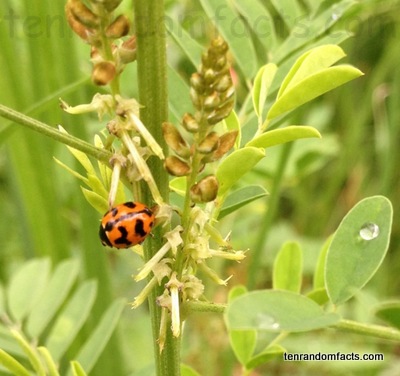A beetle… not a bug, or a bird.
- Ladybugs are also known as ‘ladybirds’, ‘lady beetles’, ‘lady clocks’, ‘lady cows’, ‘lady flies’ and ‘god’s cows’.
- ‘Ladybugs’ is one of the common names of the family Coccinellidae, which is a family of beetles, and this name is derived from the Latin word for scarlet, ‘coccineus’.
- Ladybugs have mainly yellow, orange or red elytra, or hard wings that cover the true wings, with typically black spot markings, although some species of the beetles can be a single colour, like black, brown or grey, or have different coloured spots, or have stripes instead.
- Ladybugs grow from 1 to 10 mm (up to 0.4 inches) in length, have short legs, and are usually a round or oval shape.
- There are more than 5,000 different species of ladybug, and the most common type is the seven-spotted ladybug.
- Contrary to popular belief, the spots position, amount and size on ladybugs do not contribute to age but to species.
- Most farmers like ladybugs as there are many species that eat aphids, scale insects, and other pests without any damage to the plant, although there are a few species of the beetle that eat and destroy crops.
- The name ‘ladybug’ was named after Virgin Mary, also known as ‘Our Lady’, who was often painted with a scarlet cloak, and farmers believed the beetle to be a miracle bug from God, because of its ability to eat and control pests, and some prayed to Mary to protect there crops.
- Ladybugs can withdraw their head into their body for protection and can be prey to birds, frogs, wasps, dragonflies and spiders, although the bright colours of ladybugs warn predators to stay away.
- A ladybug has an average lifespan of one to two years, which starts as an egg, develops into a larva, transforms into a pupa, and emerges as a ladybug, with a female laying up to 2,000 eggs in its lifetime.





